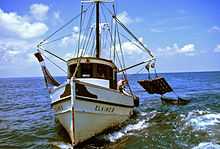Almadraba
Almadraba (Spanish, from arabic: "tuna fishing" or "netting fence to catch tuna")[1] is an elaborate and age-old Mediterranean technique for catching Atlantic bluefin tuna that was introduced by the Moors.[2][3] It consists of setting nets in a maze that leads to a central pool called "copo". In Sicily, the mazes of nets, and also the places where the nets are set are called tonnara, and the overall method of capturing the fishes is called mattanza (Italian: "slaughter").[4] This takes place during spring and the beginning of summer when tuna tend to go into the Mediterranean Sea.
The maze uses just two net lines, called "raveras". One net is connected to the shore and other line is secured in deeper water. Those lines have smaller oblique lines which lead to the central pool. This simple maze works because tuna are not able to see the exit from the central pool, and remain inside. The floor of the central pool is then raised in order to catch the tuna and when that floor is held up, there is little room left for tuna and they are then caught easily and slaughtered.
In film
See also
References


